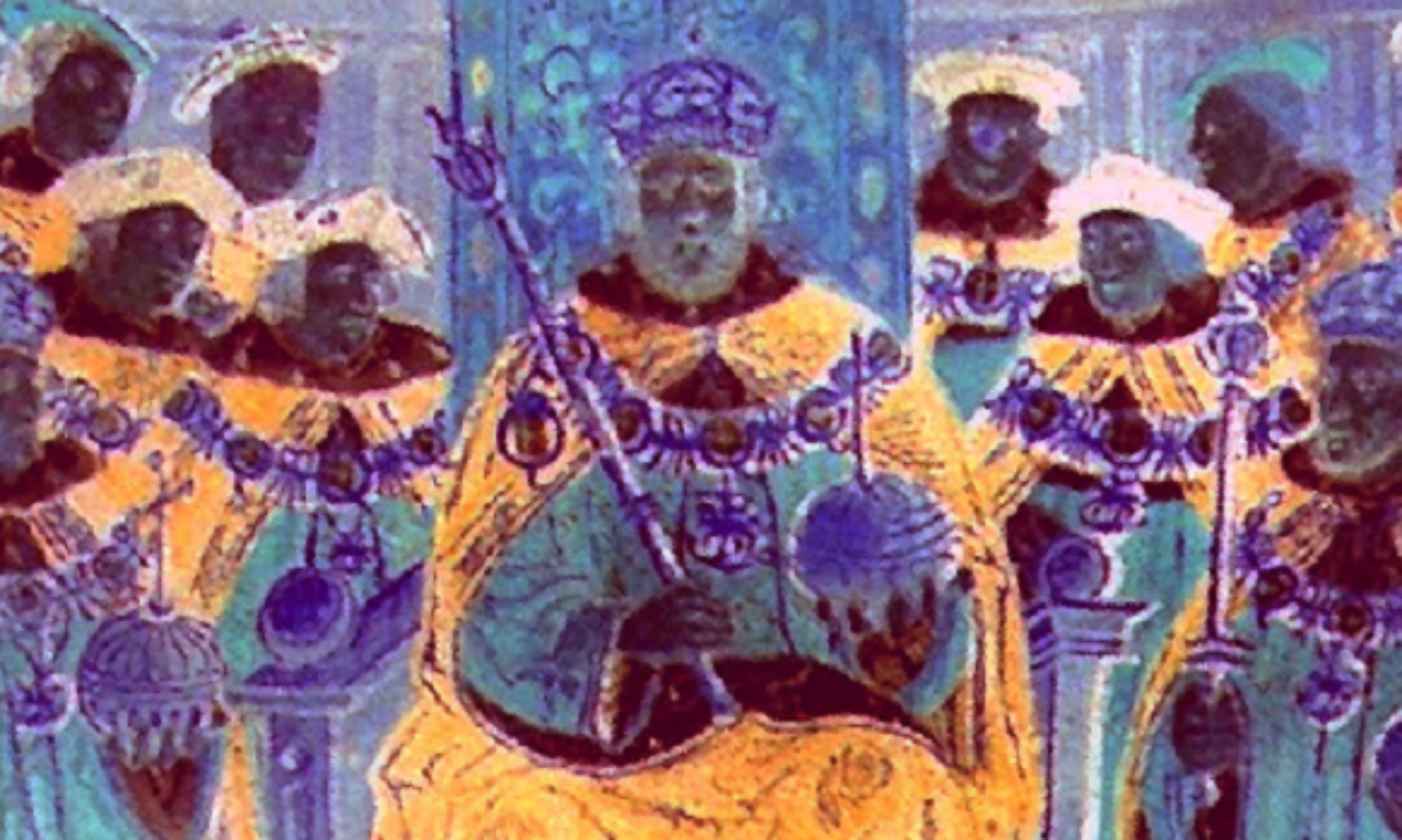Monarch’s robes
The monarch or sovereign wears a variety of different robes and other garments during the course of the ceremony:
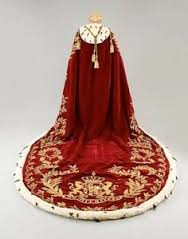 Crimson surcoat – the regular dress during most of the ceremony, worn under all other robes. This was replaced by the Coronation Dress for Her Majesty Queen Elizabeth.
Crimson surcoat – the regular dress during most of the ceremony, worn under all other robes. This was replaced by the Coronation Dress for Her Majesty Queen Elizabeth.
Robe of State of crimson velvet or Parliament Robe – the first robe used at a coronation, worn on entry to the abbey and later at State Openings of Parliament. Also called the robe of estate or imperial robe .It consists of an ermine cape and a long crimson velvet train lined with further ermine and decorated with gold lace. It is worn at the end of the coronation service in place of the crimson parliamentary robe. It is emblematic of the imperial purple of the Caesars, adopted by the Byzantine emperors, and possibly the Holy Roman Emperors.
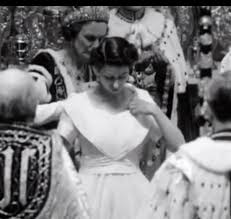 Anointing gown – a simple and austere garment worn during the anointing. A plain white garment, put on like a coat, but fastened at the back.
Anointing gown – a simple and austere garment worn during the anointing. A plain white garment, put on like a coat, but fastened at the back.
Colobium sindonis – the first robe with which the sovereign is invested. Also called the muslin undergarment, silk dalmatic, tunica or talaris. This is the first of the royal robes with which the Sovereign is invested during the coronation ceremony, and is immediately beneath the supertunica. It is a loose white undergarment of fine linen cloth edged with a lace border, open at the sides, sleeveless and cut low at the neck. It symbolises the derivation of royal authority from the people. The robe was newly made for the Queen in 1953.
 Supertunica – the second robe with which the sovereign is invested. Also called the gold surcoat, dalmatic, close pall of cloth-of-gold, or tunica palmate. It is a long coat of gold silk which reaches to the ankles and has wide-flowing sleeves. It is lined with rose-coloured silk, trimmed with gold lace, woven with national symbols and fastened by a sword belt. It derives from the full dress uniform of a consul of the Byzantine Empire.
Supertunica – the second robe with which the sovereign is invested. Also called the gold surcoat, dalmatic, close pall of cloth-of-gold, or tunica palmate. It is a long coat of gold silk which reaches to the ankles and has wide-flowing sleeves. It is lined with rose-coloured silk, trimmed with gold lace, woven with national symbols and fastened by a sword belt. It derives from the full dress uniform of a consul of the Byzantine Empire.
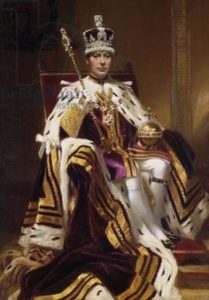 Royal Robe – the main robe worn during the ceremony and used during the crowning. Also called the cloth-of-gold mantle, pallium, royal mantle, mantle, imperial mantle or robe royal of cloth-of-gold. It is a four-square mantle, lined in crimson silk and decorated with silver coronets, national symbols and silver imperial eagles in the four corners. It is lay, rather than liturgical, in nature.[80]
Royal Robe – the main robe worn during the ceremony and used during the crowning. Also called the cloth-of-gold mantle, pallium, royal mantle, mantle, imperial mantle or robe royal of cloth-of-gold. It is a four-square mantle, lined in crimson silk and decorated with silver coronets, national symbols and silver imperial eagles in the four corners. It is lay, rather than liturgical, in nature.[80]
Stole Royal or armilla – a gold silk scarf which accompanies the Robe Royal, richly and heavily embroidered with gold and silver thread, set with jewels and lined with rose-coloured silk and gold fringing. It has a square panel at either end each with a red St George’s Cross on a silver background. On a background of floral emblems of the Commonwealth are the emblems of the four Evangelists. There are also St Edward’s Crowns, imperial eagles, and the dove of the Holy Ghost, as well as the flags of St Patrick, St Andrew and St George. The lining is of rose-coloured silk, and there are gold fringes at each end. The overall measurement is 5′ by 3″.

Purple surcoat – the counterpart to the crimson surcoat, worn during the final part of the coronation ceremony, having replaced the crimson surcoat when the Parliamentary robe was discarded. This was replaced by the Coronation Dress for Queen Elizabeth II.
Imperial Robe of purple velvet – the robe worn at the conclusion of the ceremony, on exit from the abbey. It comprises an embroidered ermine cape with a train of purple silk velvet, trimmed with Canadian ermine and fully lined with pure silk English satin. The purple recalls the imperial robes of Roman Emperors.[80]
In contrast to the history and tradition which surround the regalia, it is customary for most coronation robes to be newly made for each monarch. The present exceptions are the supertunica and Robe Royal, which both date from the coronation of George IV in 1821.
Official costume
An earl’s coronation robes
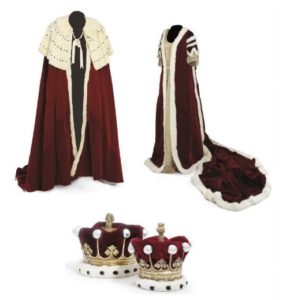 In the last 300 years Peers’ coronation robes have only been used twelve times. Peers’ robes comprise a full-length crimson velvet coat, and an ermine cape. Rows of sealskin spots on the cape designate the peer’s rank; dukes use four rows, marquesses three and a half, earls three, viscounts two and a half, and barons and lords of parliament two. Royal dukes use six rows of ermine, ermine on the front of the cape and long trains borne by pages. Peeresses’ ranks are designated not by sealskin spots, but by the length of their trains and the width of the ermine edging on the same. For duchesses, the trains are 1.8 m (2 yds) long, for marchionesses one and three-quarters yards, for countesses one and a half yards, for viscountesses one and a quarter yards, and for baronesses and ladies 90 cm (1 yd). The ermine edgings are 13 cm (5 in) in width for duchesses, 10 cm (4 in) for marchionesses, 7.5 cm (3 in) for countesses and 5 cm (2 in) for viscountesses, baronesses and ladies. The robes of peers and peeresses are used only during coronations. The canopy-bearers wear their Garter robes as well as Tudor-style underdress.
In the last 300 years Peers’ coronation robes have only been used twelve times. Peers’ robes comprise a full-length crimson velvet coat, and an ermine cape. Rows of sealskin spots on the cape designate the peer’s rank; dukes use four rows, marquesses three and a half, earls three, viscounts two and a half, and barons and lords of parliament two. Royal dukes use six rows of ermine, ermine on the front of the cape and long trains borne by pages. Peeresses’ ranks are designated not by sealskin spots, but by the length of their trains and the width of the ermine edging on the same. For duchesses, the trains are 1.8 m (2 yds) long, for marchionesses one and three-quarters yards, for countesses one and a half yards, for viscountesses one and a quarter yards, and for baronesses and ladies 90 cm (1 yd). The ermine edgings are 13 cm (5 in) in width for duchesses, 10 cm (4 in) for marchionesses, 7.5 cm (3 in) for countesses and 5 cm (2 in) for viscountesses, baronesses and ladies. The robes of peers and peeresses are used only during coronations. The canopy-bearers wear their Garter robes as well as Tudor-style underdress.
Crowns and coronets
Peers only wear coronets at coronations. The coronet is a silver-gilt circlet, with a crimson silk Genoa velvet lining, a gold tassel and a band of ermine around the base. The rank of peer is indicated by the form of the coronet he or she wears at a coronation.
A duke’s coronet is a circlet of silver-gilt (originally gold), and has eight strawberry leaves.
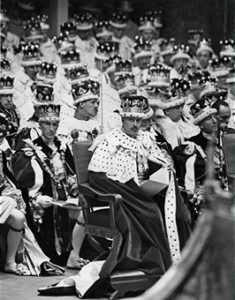 A marquesses’s coronet is a circlet of silver-gilt with four strawberry leaves alternating with four silver balls that are slightly raised on points from the rim of the coronet.
A marquesses’s coronet is a circlet of silver-gilt with four strawberry leaves alternating with four silver balls that are slightly raised on points from the rim of the coronet.
An Earl’s coronet is a silver-gilt circlet with eight strawberry leaves alternating with eight silver balls that are slightly raised on points or spikes from the rim of the coronet.
A viscount’s coronet has sixteen silver balls on the rim of the coronet.
A baron’s coronet, as befits the lowest rank, is the plainest design, with just six silver balls.
Aside from kings and queens, the only individuals authorised to wear crowns (as opposed to coronets) are the Kings of Arms, the United Kingdom’s senior heraldic officials.
